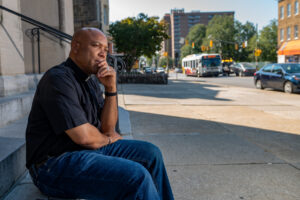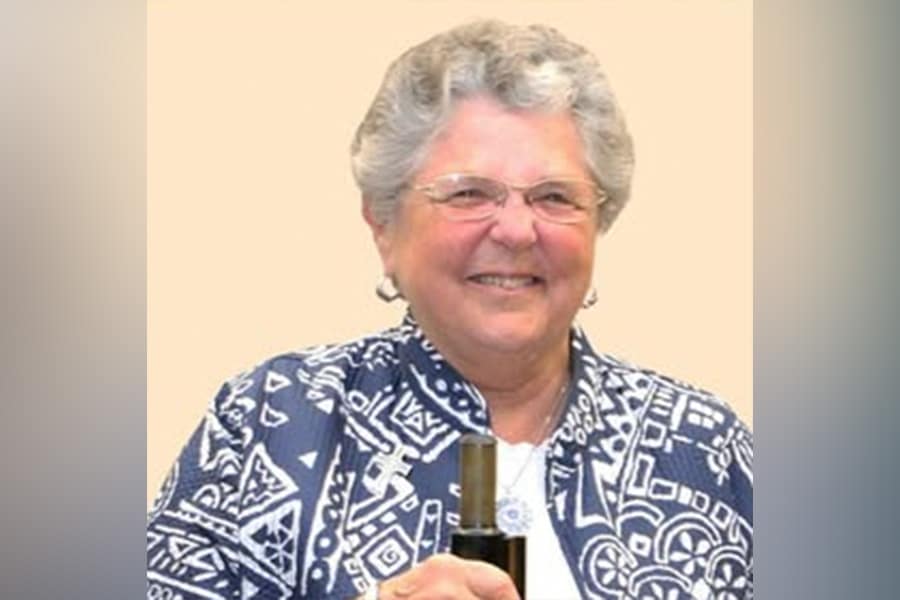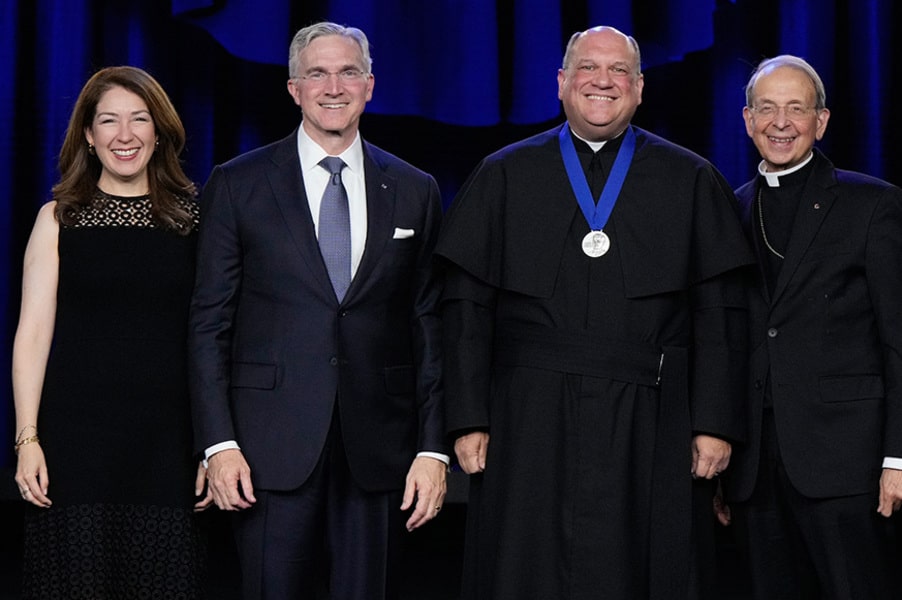If there were no Catholic churches in the City of Baltimore, what kind of church would the city and community need?
That question lies at the heart of a new initiative announced by the Archdiocese of Baltimore in late September focused on renewing parish ministry in the city, called “Seek the City to Come.”
The two-year listening and discernment process will focus on the 57 parishes in the city and a few near-in parishes in Baltimore County, with the goal of more vibrant ministry, although likely with fewer churches open for worship.
In a video announcing the effort, Archbishop William E. Lori said, “As we look at the center of our archdiocese, Baltimore City, we all too often see vivid reminders of how much God’s healing love and saving message is needed.
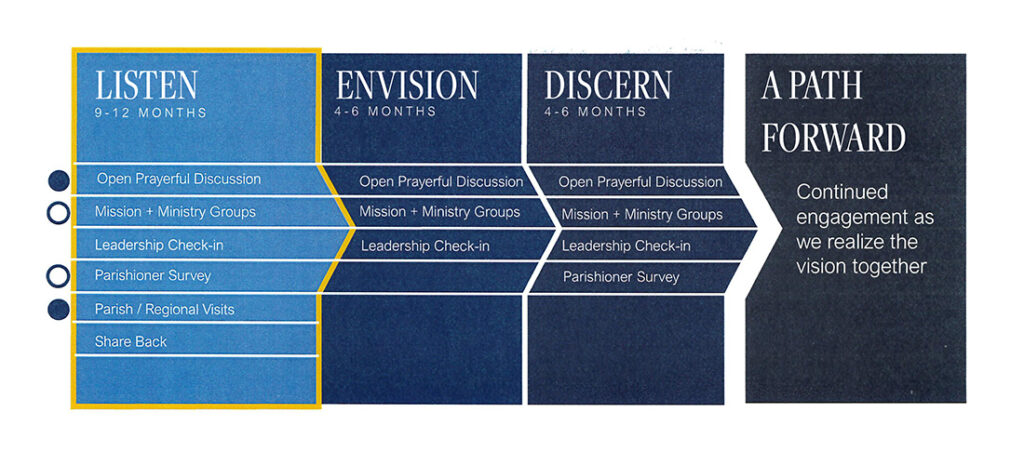
“As a church, we cannot insulate ourselves from any of this. Rather, we have to minister, not only in the neighborhoods of the city, but also to them, and more precisely, with the people who live in our neighborhoods.”
The theme for the process comes from St. Paul’s letter to the Hebrews, “For here we have no lasting city, but we seek the one that is to come” (Heb 13:14), which further says, “Do not neglect to do good and to share what you have; God is pleased by sacrifices of that kind.”
The archbishop noted that the church is at a crossroads locally and globally. “It is getting progressively harder to do more with less. The city’s population is declining – racism and gentrification have played a role in dramatic population shifts,” he said.
Studies have shown that the number of Catholics – and those affiliated with many faiths – are dropping. The COVID-19 pandemic also made ministry and participation in the church more challenging.
The process will include six to 12 months of listening, including site visits to every parish; four to six months of discussion to envision the future; and four to six months to discern the next steps. Implementation could take years, with the goal to bring new life, energy and pastoral activity. New structures or buildings could also be considered.
Archbishop Lori made clear the church is not pulling back from the city. “It is a matter of how we are to dive deeper, how we are to invest more. We’re always going to be here. The question is how will the church be present and active in our beloved city?”

As urban vicar, Auxiliary Bishop Bruce A. Lewandowski, C.Ss.R., will guide the process, with the support of Geri Royale Byrd, who is leading and facilitating the effort.
Bishop Lewandowski noted that churches that are open now might eventually be used for something else that serves the area, such as housing, training centers, daycare or senior centers, and outreach to the poor and those without homes.
The archdiocese is supporting churches and locations that served the city well “in the 1950s or even the 1980s, but they don’t serve the church today,” he said, adding that parishes need to ask their neighbors what a church needs to do for them and how a church can best serve them.
He said some churches have become too insulated. They may say they serve the community by giving out food or other services.
“And my question is, did you ever ask them to come inside? Did you ever invite them to church or at least pray with people?” Bishop Lewandowski said. He responds to those who say they don’t wish to proselytize by saying if they had been inviting people all along to pray with them, they might not be in a dire situation.
“The reason you’re feeding people is because you’re Catholic and there’s no reason you shouldn’t share that,” he said.
Although Catholic Charities does a great job serving the needs of people throughout Maryland – as the largest nongovernmental provider of services in the state and the third-largest Catholic Charities agency in the country – parishes need to be doing that as well, the bishop said.
“We have churches that are very strong on social justice issues, but not necessarily the social justice issues that are pertinent for their neighborhood,” Bishop Lewandowski said. For example, he noted that he knows of no parishes fighting for good housing in a city that has 15,000 vacant houses.
“Actually, our parishes are disconnected significantly from Catholic Charities in the work there, when there would be tremendous value for them to connect.”
Those involved in the planning process emphasize that the effort is not just about numbers – of parishes or parishioners – but they help tell the story.
Bishop Lewandowski noted that the archdiocesan facilities office has calculated that if each Catholic church in the city had Mass at one given time – for example, 10 a.m. on a Sunday – there would be seats for 25,000 people, but that Mass attendance at all times for all the parishes in the city on a typical weekend is fewer than 2,000.
City parishes accounted for about 840 baptisms last year, but more than half of those were at just four parishes combined, with the other 400 or so baptisms spread out among the other 53 parishes, he said.
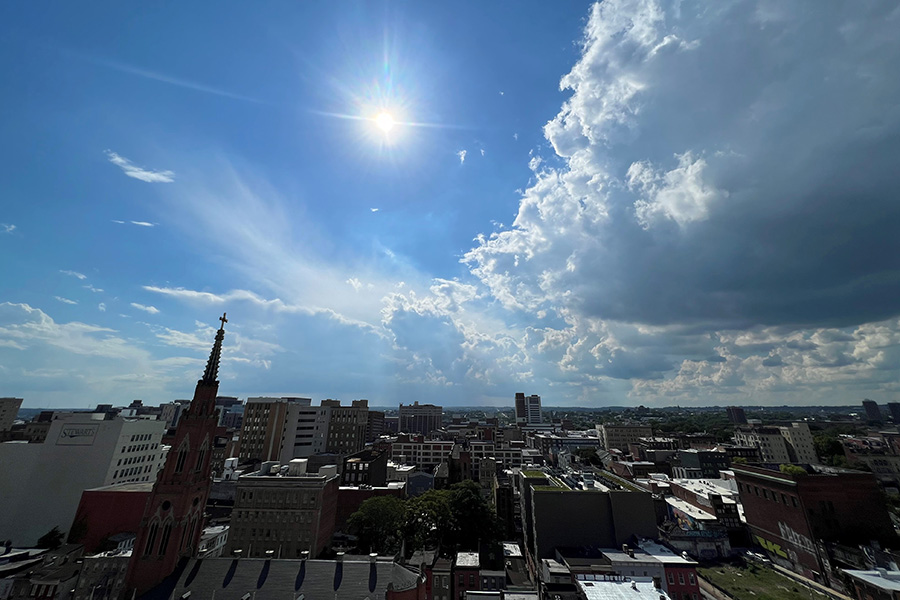
“The majority of churches in the city have many more funerals than baptisms. Some have not had baptisms or weddings for years,” Bishop Lewandowski said.
“If we don’t do something now, the decisions will be made for us by lack of people, lack of finance and buildings with deferred maintenance,” he said.
“The Holy Spirit is speaking through the neighborhoods and the people in those neighborhoods, which unfortunately over the course of time we’ve become disconnected from.
“So, this is not a running away from the city. I see it as a rush toward the city and the people living here in the neighborhoods and asking what kind of church do you need us to be for you?”
There are more churches, many of which are struggling, and priests in the city than the population calls for, the bishop said. “I would rather have fewer, more effective churches in the city doing really, really vibrant, strong ministry that meets the needs of the people where we are both spiritually and physically.”
There are some good ministries that could be shared citywide, such as young adult ministry, that could be coordinated between sites. “I think more shared ministries, shared apostolates, shared initiatives, shared services will be the goal,” he said.
Models of parish life could emerge from the listening and discernment over the next 18-24 months.
Byrd, who is leading the project, has already participated in a few large meetings with clergy and parish leaders to set the stage for the urban initiative. She has answered questions one-on-one as well.
The effort “incorporates and will incorporate every gift and every asset that every parish in this entire urban vicariate has and is capable of giving. I feel like it really is about being able to reach out and be able to engage the community and really understand what it is to be a real disciple,” she said.
Sometimes, it helps to be in an uncomfortable situation, because it leads to the greater good of spreading Christ’s light. “That really is what ‘Seek the City to Come’ is really all about.”

She added the effort could include retooling current resources and bring in new ones where needed, because there is a lot of duplication in the Urban Vicariate, and that is not sustainable in the long term.
The mission is to understand the communities served by parishes. “The parishes in our city and in the Urban Vicariate anchor very strong neighborhoods – and some of them need a lot of love and care,” Byrd said.
But she said some people seem to be more loyal to their parish and a certain building than to the church as a whole and its mission of salvation. “Christ wasn’t here for brick and mortar; he didn’t come here to save brick and mortar. He came to us to save people, and so if we’re really following him and if we are doing as he would want us to do, then we have to recognize what our real mission is.”
Ellen Marshall, a member of the pastoral council at the Epiphany pastorate in northeast Baltimore – which includes her home parish of St. Anthony of Padua along with Most Precious Blood and St. Dominic in Hamilton – said she hopes the process will not be just about numbers and people in the pews.
The idea that a large number of city parishes can be put together “to equal the numbers in one suburban parish is not going to work,” she said.
She noted that some populations in the city such as communities of color and immigrant populations may not have access to transportation and won’t be able to walk to church if their nearby parish is closed.
She also believes it is not wise to group all of one ethnic community into one parish such as a parish specifically for the Hispanic community. “We need to be reflecting our diverse communities. … I want to see our churches reflecting what our city has become,” Marshall said.
She also thinks wealthier parishes need to step up to support the struggling city parishes so they can survive. At some point, she said representatives of those parishes need to be a part of the process if parishes outside the city will be asked to support the city with financial or human resources.
She said there has been a lot of energy and trust in the room at the meetings she has already attended about the initiative “and there’s also a lot of hope that the laity will be listened to.” She hopes that when Bishop Lewandowski and others say that the church may exist in a different form – including closing parishes for worship but keeping the facility for social justice ministry – that it’s not the only option.
“We all love our churches, we all associate with our churches,” Marshall said, noting that her family has been at St. Anthony for four generations.
She also hopes the Archdiocese of Baltimore, as the premier see in the country, can be a trendsetter in finding ways to keep urban parishes alive.

According to Byrd, visits to individual parishes and clusters of parishes will take place beginning in October through spring 2023. Each will include a Mass; a tour of the campus looking at the facilities in terms of utilization for ministry; and meetings with parish leadership and a focus group.
Byrd said the pain and violence in the city point out a lack of love. Choking back tears, she thought about the recent incident in which a “squeegee boy” shot and killed a man who had approached the group of teens with a baseball bat. “When you take somebody else’s life, you actually don’t love yourself and you don’t know what it’s like to be loved either, right?
“I look at this initiative honestly as an opportunity for us,” she said. “How do we rethink how we represent the Catholic Church in our neighborhoods and in our city, and for neighborhoods and a city that need us the most?”
The violence in the city touches many parishes, including St. Bernardine in Edmondson Village in West Baltimore, where Monsignor Richard Bozzelli is pastor.
Young people have been killed right in front of the parish hall and just across the street from the church. Two were shot in a different location but came to St. Bernardine to die on the church or rectory steps.
“One advantage of living in the neighborhood is I experience the disruption of violence in our neighborhood. I hear the gunshots,” Monsignor Bozzelli said.
He knows the parish alone cannot solve all the problems of poverty and violence in the city. “Maybe the first question is how do we minister and witness to the Good News in the midst of violence? And to me that means how do we give our residents, our neighbors a sense of hope in the midst of a very frightening situation?”
He said part of that is developing relationships with the young people in the community, to try to understand them and speak their language.
Because of arsons and other violence, “There was one night where the neighborhood was literally burning down around us and I started feeling like I was a failure, and I only got out of that by one saying, well, nobody else has solved the problem, you know, why should I think I can solve the problem?
“Maybe my role isn’t to solve the problem right now. Maybe my role is to engage the community and let the people know we’re still here, we’re not going anywhere,” Monsignor Bozzelli said. “We’re going to be with you. So even if all we can do is suffer with you, we will suffer with you. But we are not going to walk away from you.”
At St. Edward Parish, also on the west side, Spiritan Father Uju Patrick Okeahialam, pastor, said it is not always easy to engage the community. “You are speaking about a secular society whereby you have people who believe and people who don’t believe; people who are Catholics, people who are not Catholics; people who are Christians, people who are not Christian, and so this is the nature of the secular society.
“At this moment, I think we’ve been what I call a ministry of presence, because we are there, the church is there, and the people know the church is there,” he said. The parish is an outlet for food distribution and has partnered with the Archdiocese of Baltimore and the health department to be a center for COVID testing, vaccinations and boosters.
But the parish has not done much direct engagement in the community such as going door-to-door to invite people to the parish. Most of his parishioners commute to the parish from the outside the city.
“They don’t live in the neighborhood, but this has been their church, their family church where they were baptized. It’s more of attraction of history that brings them here. So, I’m in the process of trying to meet with the few people who live around the church for us to see how we can engage the outside society, the neighborhood, because they live close by. They may know their neighbors more than I do,” Father Okeahialam said.
His church can hold 500 people but in the year that he has served as pastor, there have never been more than 60 present for Mass.
He looks forward to the site visit from the planning committee, though he wishes the meeting could be open to all the parishioners, rather than just a small group that includes pastoral and finance council members and parish corporators. However, he realizes a large group could become difficult for everyone’s voice to be heard, so he welcomes the chance to discuss with his parishioners as the process continues.
Bishop Lewandowski said Archbishop Lori and the team embrace the synodal process that was utilized over the last year in gathering feedback from Catholics for an upcoming World Synod of Bishops at the Vatican. “My hope is that through this two-year process of listening and moving toward action, we’ll trust the power of the Holy Spirit and each other and that great things will happen.”
After about six to nine months of listening, the group hopes to take what they have heard and ask where the Holy Spirit is speaking.
“Where are we being led by the Lord to be church today?” the bishop asked. “Does that imagine that churches that are that are currently open now might later be used for something else that serves the area? I think we have to be honest with ourselves and say that the church’s footprint in this city will look different after this process.”
Bishop Lewandowski said it is important that the faith not be connected so much to the buildings. “I wonder sometimes if we have promoted faith in a building, in a church and not faith in the Lord. And so people are holding onto buildings.”
Young people, especially, are not focused on buildings these days, instead believing “it’s my faith in the Lord and this gathering of people in community and that can happen anywhere.”
He noted that when he was pastor of Sacred Heart of Jesus/Sagrado Corazón de Jesús Parish in Highlandtown, he marveled at the number of people going to storefront churches on Sunday. “There were so many people going into these yoga studios on Eastern Avenue for church services and not coming to this beautiful building that we have on Conkling Street and it’s because the relationship is more important than the place, and the relationship can be taken anywhere.
“And so, the church of today, which I think we’re going to see more and more, is community, relationship, friendship, bonds of love, kindness, mercy, compassion, patience, forgiveness. All of those things can happen anywhere.”
Email Christopher Gunty at editor@CatholicReview.org
To read Archbishop Lori’s statement on “Seek the City to Come,” click here.
For more information about Seek the City to Come, click here.
Editor’s note: This story was updated Oct. 3 to correct the spelling of Monsignor Richard Bozzelli’s name.
Read More Local News
Copyright © 2022 Catholic Review Media
